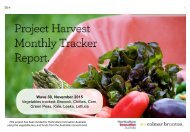vegetables
VA-MayJun2016
VA-MayJun2016
Create successful ePaper yourself
Turn your PDF publications into a flip-book with our unique Google optimized e-Paper software.
22<br />
Ask the industry<br />
Two-spotted mite. Photo courtesy of<br />
Clemson University – USDA Cooperative<br />
Extension Slide Series, Bugwood.org.<br />
with Scott Mathew<br />
R&D<br />
Farm Productivity,<br />
Resource Use<br />
& Management<br />
Recently, I’ve been getting<br />
a few phone calls about<br />
a number of insects that are<br />
causing more issues than<br />
normal, particularly in some<br />
of the areas surrounded by<br />
broadacre farms. I believe this is<br />
due to some early summer rain<br />
causing a flush of weed growth,<br />
promoting the build-up of insect<br />
populations. These weeds have<br />
then been sprayed by farmers<br />
over the summer period,<br />
encouraging insects to migrate<br />
to the only green food source<br />
around – irrigated horticultural<br />
crops.<br />
A couple of insects that have<br />
been particularly busy are<br />
Potato moths and mites.<br />
Potato moths<br />
Potato moths, also known as<br />
Tuber moths (Phthorimaea<br />
operculella), are one of the<br />
most damaging potato pests in<br />
Australia. High count numbers<br />
have been reported in some<br />
of the South Australian potato<br />
growing regions over the last<br />
few weeks. Potato moth larvae<br />
POTATO MOTHS AND TWO-SPOTTED MITES HAVE BEEN<br />
PARTICULARLY TROUBLESOME IN RECENT MONTHS. SYNGENTA<br />
TECHNICAL SERVICES LEAD SCOTT MATHEW EXPLAINS HOW TO<br />
RECOGNISE THESE PESTS AND HOW TO MANAGE THEM.<br />
mine in foliage, stems and the<br />
tubers of potatoes. They are<br />
particularly damaging during<br />
periods of warm, dry weather.<br />
The adult moth is identified by<br />
its narrow, silver-grey body and<br />
greyish-brown wings (wingspan<br />
12-16mm) that are patterned<br />
with small, dark specks. The<br />
moths are mainly active at<br />
dusk but can be seen flying<br />
sporadically in the potato crop<br />
during the day.<br />
The Potato moth lays oval<br />
eggs on the underside of potato<br />
leaves and on any exposed<br />
tubers. When first laid, the eggs<br />
are pearly white; changing to<br />
yellow on maturity and to black<br />
just before hatching. After<br />
hatching, the larvae continue<br />
to grow to an adult size of<br />
15-20mm. The complete life<br />
cycle takes between four to five<br />
weeks. If left untreated, the<br />
larvae cause extensive damage<br />
to both foliage and tubers.<br />
In order to minimise damage<br />
from Potato moth close to<br />
harvest, you should carefully<br />
monitor pest numbers. If<br />
detected, decide on the<br />
appropriate control measure.<br />
It is often beneficial to apply<br />
an insecticide just before the<br />
potatoes are desiccated to<br />
prevent the insect larvae from<br />
entering the soil and moving<br />
down to damage the tubers.<br />
Two-spotted mites<br />
The mite is another insect that<br />
prefers warm, dusty conditions<br />
over the summer period<br />
and has been causing some<br />
concerns in horticultural crops<br />
recently. Two-spotted mites<br />
(Tetranychus urticae) thrive in<br />
these conditions and can be<br />
easily spread by wind and on<br />
i<br />
clothing, machinery and birds,<br />
and have been more active<br />
than normal in recent weeks.<br />
The adult Two-spotted mite<br />
has an oval-shaped body<br />
about 0.4mm long. It has<br />
eight legs and a characteristic<br />
dark spot on each side of the<br />
body. Its eggs are round and a<br />
translucent pale yellow when<br />
laid; as they develop, they<br />
become reddish. They are<br />
often deposited in clusters on<br />
the under surface of the leaf.<br />
When monitoring, pay<br />
particular attention to cropping<br />
areas that are dusty; for<br />
example, farm tracks, laneways<br />
and ends of rows.<br />
For more information or to ask a question, please contact your local<br />
Syngenta Territory Manager, the Syngenta Advice Line on 1800 067 108,<br />
visit syngenta.com.au or email Vegetables Australia:<br />
info@ausveg.com.au. Please note that your questions may be published.<br />
The R&D content for this article has been provided to Vegetables<br />
Australia to educate Australian vegetable growers about the most relevant<br />
and practical information on crop protection technologies and their<br />
on-farm applications. This communication was funded by Horticulture<br />
Innovation Australia Limited using the National Vegetable Levy and funds<br />
from the Australian Government.<br />
Project number: VG15027<br />
Two-spotted mite.<br />
Photo courtesy of David<br />
Cappaert, Michigan State<br />
University, Bugwood.org.<br />
Potato moth.<br />
Image courtesy of Central Science Laboratory,<br />
Harpenden, British Crown, Bugwood.org.








